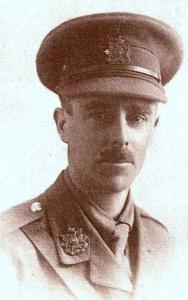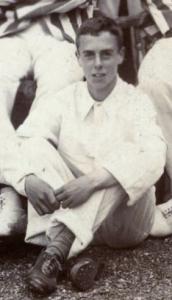
|

|
| Captain Noel Martyn SAUNDERS | |
|
C Company, 7th (Service) Battalion Border Regiment (Westmoreland and Cumberland Yeomanry) Date of birth: 20th September 1883 Date of death: 20th October 1918 Killed in action aged 35 Buried at Amerval Communal Cemetery Extension, Solesmes Row A Grave 9 |

|
| Noel Martyn Saunders was born at Truro in Cornwall on the 20th of September 1883 the son of the Reverend Clement Morgan Saunders, Rector of Rumboldswyke, and Edith Montgomery (nee Keene) Saunders later of "Hollyhurst", Lower Green Road, Rusthall, near Tunbridge Wells in Kent. He was christened at St George's Church, Truro on the 28th of October 1883. He was educated at Lancing College where he won a scholarship and was in School House from September 1895 to April 1903. He was member of the Football XI from 1900 to 1903. He was a member of the Cricket XI from 1900 to1902 being Captain in 1902 and Sports 1902 to 1903. He was awarded his colours for cricket in February 1903. He was a member of the Shakespearian Society, the Officer Training Corps and was appointed as a Prefect in 1901. Of his football, the Lancing College Magazine wrote the following in March 1901:- "Outside left--Is the fastest forward in the team. Did yeoman service in the Christmas Term, but has gone off lately. Combines well with his inside, but centres weakly often preferring to shoot." In 1902 the magazine wrote of his cricket season:- "A steady bat with sound defence. Failed to do himself justice in the Easter matches, but has lately played some excellent innings especially against Brighton College. A fair change bowler, and very safe field at mid-off. Is leaving." On leaving school he went to India in 1907 and became a schoolmaster at Bishop Cotton Boy's School in Bangalore where he coached the school hockey team and wrote the school song. He later went into business as a merchant in Travancore. While India he held a commission in the Bangalore Rifle Volunteers from 1907 to 1908 and also served with the Southern Provinces Mounted Rifles. He was married at Darjeeling on the 31st of March 1913 to Norah (nee Garrick) Saunders and they lived at Pallamcottah, Tinnervelly in Southern India; they had a daughter born on the 12th of June 1915. When they returned to England the family lived at "Fallowfield", Hilbury Road, Warlingham in Surrey. Following the outbreak of war he enlisted at St James in London as Private 790 in the University and Public Schools Corps on the 17th of September 1914. At a medical examination, which was held on the same day, it was recorded that he was five feet six inches tall, that he weighed nine stone and that he had brown eyes and black hair. He served with them until the 4th of December 1914 before being commissioned as a 2nd Lieutenant on the 6th of February 1915. He landed in France on the 2nd of February 1917 and proceeded to Etaples where he and seven other officers joined the 7th Battalion Border Regiment in the field at Bronfay Camp on the 6th of February. He was promoted to Temporary Captain on the same date. On the 23rd of April 1917 he was given command of C Company and from the 10th of July to the 20th of July 1917 he returned home on leave. On the 19th of August 1917, while the battalion was in trenches at Gavrelle near Arras, he was admitted to 52nd Field Ambulance, was transferred to 38th Field Ambulance the following day and returned to duty on the 31st of August. On the 25th of December 1917 he was admitted to the No. 2 British Red Cross Hospital and was released to the Depot at Etaples on the 4th of January 1918. He rejoined his battalion in the field on the 16th of January and went on leave from the 23rd of January to the 6th of February 1918. On the 21st of March 1918 the Germans launched their long expected spring offensive. That morning the 7th Battalion Border Regiment were in trenches at Havrincourt where they stood to arms at 5am and suffered from heavy shelling throughout the day but with few casualties. By the 25th of March the battalion was holding the high ground near the village of Bazentin-le-Grand and on the 26th of March they marched to Henencourt and then to Millencourt. At 10.45pm on the night of the 27th of March they took over front line trenches from a battalion of the Suffolk Regiment. They were in position by the early morning of the 28th of March 1918 where they came under enemy artillery fire and Noel Saunders was wounded. He was admitted to a Casualty Clearing Station with a gunshot wound. He was moved to 20 General Hospital on the 30th of March and on the 1st of April he was evacuated to England on the Hospital Ship "Princess Elizabeth". He recovered and rejoined his battalion in the field on the 23rd of June 1918 and resumed command of C Company on the same day. On the 10th of September 1918 he returned to England and reported to the Adjutant of the Honourable Artillery Company at the Tower of London. He returned to France and joined his battalion in the field at Montigny on the 16th of October 1918. On the 20th of October 1918 the 7th Battalion Border Regiment was part of the Allied advance which was sweeping the German army before them and was only two weeks away from outright victory. Their task that morning was the capture of the village of Amerval near Le Cateau and the attack began at 2am. Having successfully captured the village the Borders were forced out again as the Germans counterattacked. They again assaulted the village and regained control of it just after dark. During this phase of the fight for the village the Commanding Officer of the battalion, Lieutenant Colonel William Edgar Thomas DSO MC and Noel Saunders, were both shot and killed by German snipers. His wife received the following telegram dated the 25th of October 1918:- "Deeply regret Capt N.M. Saunders Border Regt was killed in action October twentieth. The Army Council express sympathy." He was mentioned in dispatches twice, once in the London Gazette of the 7th of April 1918 and was unsuccessfully recommended for the Military Cross on three occasions. He was wounded twice. He is commemorated on the war memorial at St Stephen's Church in Bournemouth and on a plaque in St Philip's Church, Burwash Common where his father was vicar from 1888 to 1903. |
|
 | |
| School House |
Back